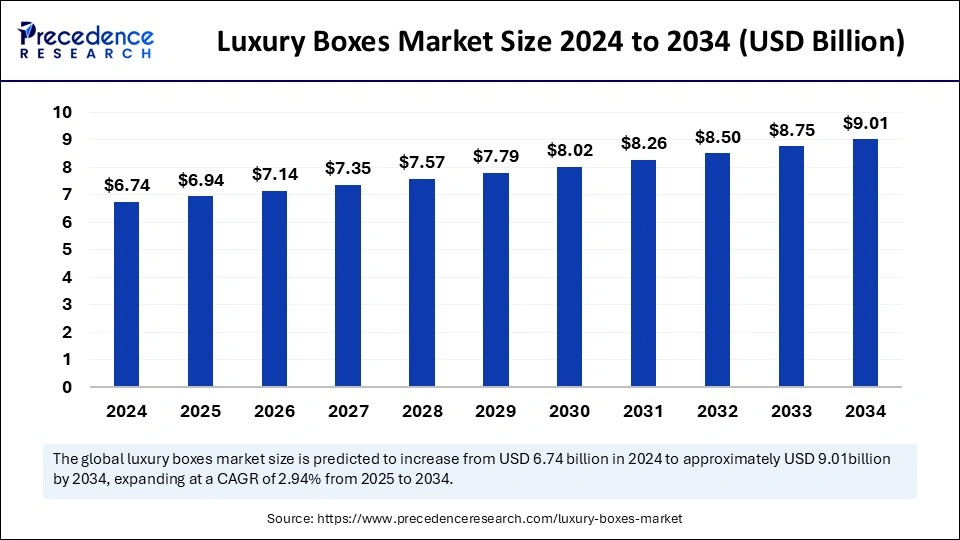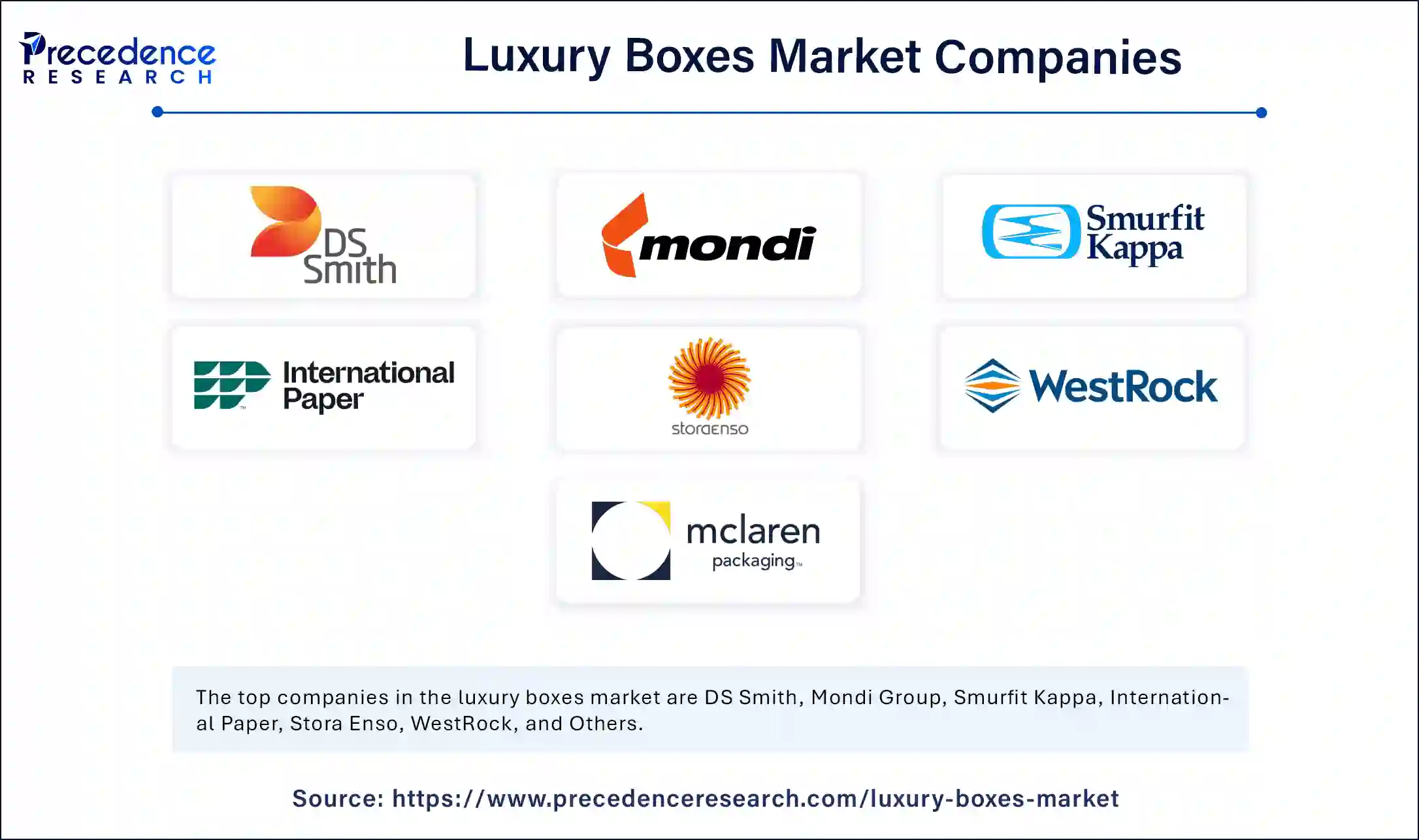August 2024
The global luxury boxes market size accounted for USD 6.74 billion in 2024 and is predicted to increase from USD 6.94 billion in 2025 to approximately USD 9.01 billion by 2034, expanding at a CAGR of 2.94% from 2025 to 2034, growing due to the increasing demand for premium packaging, personalized experiences, and sustainable solutions. Also, the rising consumer preference for eco-friendly and visually striking packaging is driving further expansion in the industry.

Artificial intelligence is transforming the luxury boxes market by introducing precision, customization, efficiency, and security. Brands can create customized designs, interactive features, and environmentally friendly solutions that improve customer engagement thanks to sophisticated algorithms. Production is streamlined, waste is decreased, and resources are optimized through intelligent automation, which increases the sustainability of processes. Furthermore, clever security features like RFID tracking and blockchain verification protect authenticity and boost brand credibility.
Machine learning helps analyze market trends, allowing businesses to stay ahead with innovative and data-driven packaging strategies. Virtual prototyping speeds up the design process while preserving creativity and cutting costs. Supply chain management is further improved by predictive analytics with guarantees of smooth operations and on-time delivery. As technology develops, clever solutions will continue to influence premium packaging, guaranteeing a smooth fusion of exclusivity and innovation while redefining the way luxury brands interact with their target market.
The luxury boxes market is experiencing an enormous boom, driven by the increasing demand for top-class packaging throughout industries together with style, cosmetics, earrings, and gourmet products. With growing disposable earrings and evolving client preferences, brands are investing in excessive stop packaging to enhance product value and client experience. The surge in e-trade and social media influence has similarly fueled the marketplace, as visually appealing packaging plays a critical role in unboxing reports and brand differentiation.
Sustainability also changes the industry. This allows the brand to include environmentally friendly materials and innovative designs to meet consumer demand for responsible luxury. Technological advances such as intelligent packaging, segmented reality, and personalization give exclusivity and commitment to creating gorgeous boxes that are more than just containers. They are now key elements of storytelling and brand identity. As a result, the global luxury packaging market will continue its upward trend for the next few years.
| Report Coverage | Details |
| Market Size by 2034 | USD 9.01 Billion |
| Market Size in 2025 | USD 6.94 Billion |
| Market Size in 2024 | USD 6.74 Billion |
| Market Growth Rate from 2025 to 2034 | CAGR of 2.94% |
| Dominating Region | Europe |
| Fastest Growing Region | Asia Pacific |
| Base Year | 2024 |
| Forecast Period | 2025 to 2034 |
| Segments Covered | By Type, Application, and Regions. |
| Regions Covered | North America, Europe, Asia-Pacific, Latin America, and Middle East & Africa |
The rise of interactive luxury packaging
With upgrades in AR, QR codes, and NFC generation, high-surrender manufacturers are transforming boxes into virtual gateways. Imagine scanning a package deal to free up a great behind-the-scenes video, a customized thank-you message, or a digital try-on to enjoy. This fusion of generation and layout depends on brand engagements. Growing immersive packaging elevates the unboxing moment, making it now no longer without a doubt visually attractive but furthermore digitally enriching. In the evolving global luxury market, engagement is today’s exclusivity.
Innovations in sustainable high-end materials
Luxury brands are experimenting with new sustainable materials that maintain the premium look and feel of traditional luxury packaging. Materials like mushroom-primarily based biodegradable leather, recycled bottle-alloyed cardboard, or hemp-primarily based inflexible containers are gaining traction; those ingredients offer an acceptable yet abundant look, ensuring that luxurious brands can align with eco-friendly initiatives without sacrificing company status. As acceptable options evolve, luxurious packaging turns into a must-have part of eco-aware company strategies.
Sustainability challenges
While eco-friendly luxury packaging is in demand, finding sustainable materials that maintain a high-end look and feel can be challenging and costly. Conventional luxury packaging uses non-recyclable materials like metallic finishes, foam inserts, and plastic laminates that are hard to swap out without sacrificing the high-end appearance. Many eco-friendly substitutes don't have the same opulent feel, which makes it challenging to satisfy aesthetic and environmental requirements. Long-term storage and transportation may also be impacted by the shorter shelf lives or recyclable and biodegradable alternatives. Brands must also instruct customers on how to reuse or dispose of upscale packaging, which complicates sustainability initiatives even more.
Growth of the direct-to-consumer (DTC) luxury market
With more luxury brands selling directly online, premium e-commerce packaging is becoming a vital branding tool. Purchasing branded inserts, magnetic closures, and shipping boxes that are both elegant and safe adds to the upscale appearance of online purchases. Replicating the in-store luxury atmosphere at home is made easier with exclusive DTC unboxing experiences. Online buyers of luxury goods anticipate packaging that matches the product's uniqueness. Customized elements such as handwritten thank-you notes, velvet-lined interiors, and fragrance-infused packaging can make an impression that will keep customers coming back.
Innovations in anti-counterfeiting technology
Luxury brands face increasing threats from counterfeit markets, making secure packaging solutions a major opportunity. To protect brand integrity and reassure customers, packaging can incorporate hologram tags, blockchain authentication, and tamper-proof seals. Brands that invest in luxury boxes with enhanced security will gain more consumer trust as counterfeiting keeps increasing. To guarantee authenticity from production to sale, Louis Vuitton, for example, has investigated blockchain-based tracking. In addition to safeguarding the brand, these security features boost consumer confidence, increasing their willingness to spend money on luxury goods without worrying about fraud.
The paper segment dominated the luxury boxes market with the largest share, primarily due to its versatility, cost-effectiveness, and eco-friendly properties. Paper-based luxury boxes are preferred by luxury brands in a variety of industries, including food packaging, clothing, and cosmetics, due to their ability to support intricate designs, high-quality printing, and sustainable branding. Paper is now the preferred material for luxury packaging manufacturers due to the growing consumer preference for recyclable and biodegradable packaging options.
More customization is possible with paper-based luxury boxes, which aids brand differentiation in a crowded market. Paper materials are now more durable and have high-end finishes, thanks to developments in packaging technology, which further increases their appeal to luxury brands. Global governments and regulatory agencies are also pushing environmentally friendly packaging options, which is increasing the demand for luxury boxes made of paper. To satisfy the growing demand from consumers who care about the environment, big packaging companies are investing in creative paper packaging solutions.
The wood segment is expected to grow at the fastest rate in the market during the forecast period, driven by its premium appeal, durability, and sustainability. Wooden packaging is becoming more and more popular in high-end industries like jewelry, watches, and premium beverages to increase brand value and offer a unique unboxing experience. Wood's growth has also been aided by the growing trend of eco-friendly luxury packaging as consumers look for elegant yet sustainable substitutes for conventional packaging materials.
Wooden boxes are a popular option for high-end and limited-edition products because they are frequently linked to exclusivity and craftsmanship. Wood is also more widely used in the luxury market since it provides excellent protection for expensive and delicate items. Wooden packaging innovations like lightweight and adaptable styles are also assisting companies in incorporating sustainability without sacrificing style. It is anticipated that demand for wooden packaging solutions will increase dramatically as luxury brands continue to highlight eco-friendly initiatives.
The food and beverages segment dominated the global luxury boxes market with the largest share, driven by the rising demand for premium packaging in gourmet foods, fine wines, and high-end confectionery. Consumers associate elegant packaging with superior quality, leading brands to invest heavily in aesthetically appealing and functional luxury boxes.
Paper, which is still the most popular material type because of its affordability, eco-friendliness, and capacity to accommodate complex designs and branding, is also in high demand due to the food and beverage industry's growing preference for sustainable packaging options. To improve consumer satisfaction, maintain product freshness, and establish a distinctive brand identity, luxury food brands employ specialized packaging.
The jewelry segment is expected to grow at the fastest rate in the luxury boxes market as brands focus on creating an exclusive unboxing experience for high-value products. Sophisticated, safe, and aesthetically pleasing packaging has become increasingly necessary as disposable income and consumer preference for high-end accessories have increased. At the same time, wood is becoming the material used in luxury packaging with the fastest rate of growth because of its premium appearance, eco-friendliness, and durability. Expensive watches, jewelry, and collectibles are frequently packaged in wood, which adds a touch of exclusivity and sustainability that complements contemporary luxury trends.
To improve the overall consumer experience, luxury jewelry brands are utilizing cutting-edge packaging designs such as velvet linings, magnetic closures, and soft-touch interiors. Furthermore, a lot of companies are now adding elaborate craftsmanship and personalized engraving to wooden boxes, turning them into collectible objects in and of themselves. Luxury jewelry companies are moving toward wooden packaging made from ethical sources as sustainability becomes a top priority, which is increasing the demand for this rapidly expanding market.
Europe dominates the luxury boxes market with the largest share, driven by its rich heritage of luxury craftsmanship and a well-established luxury goods sector. The growing consumer preference for eco-friendly and recyclable materials has further boosted the demand for high-quality paper and wooden packaging solutions. Furthermore, Europe's dominance in the market is strengthened by strict environmental laws that push companies to use eco-friendly luxury packaging techniques. Europe continues to set global trends in luxury packaging thanks to a robust retail industry and a strong premium product presentation culture.
Asia Pacific is expected to grow at the fastest rate in the luxury boxes market during the forecast period, fueled by rapid economic development and a rising demand for high-quality packaging solutions. Luxurious boxes that are both aesthetically pleasing and long-lasting are becoming increasingly necessary to improve the unboxing experience as e-commerce platforms and digital retailing gain popularity. Additionally, the growing demand for high-end goods and the influence of Western lifestyles are pushing brands to make investments in creative and culturally relevant packaging designs. The use of environmentally friendly luxury packaging materials in the area is also being encouraged by government programs that support sustainability and domestic manufacturing.
North America holds a notable position in the luxury boxes market, characterized by a mature luxury goods industry and a strong emphasis on branding and consumer experience. Due to the region's emphasis on innovation and technology, smart packaging solutions have been developed incorporating features like NFC tags and QR codes to engage customers and verify authenticity. Brands are also looking into using recyclable and biodegradable materials for their luxury boxes in response to the growing consumer demand for packaging that is ethically and sustainably made. Customized and immersive packaging designs that appeal to the regions' diverse consumer base are being created.

By Type
By Application
By Geography
For inquiries regarding discounts, bulk purchases, or customization requests, please contact us at sales@precedenceresearch.com
No cookie-cutter, only authentic analysis – take the 1st step to become a Precedence Research client
August 2024
August 2025